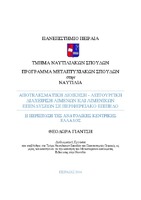Αποτελεσματική διοίκηση - λειτουργική διαχείριση λιμένων και λιμενικών επενδύσεων σε περιφερειακό επίπεδο : η περίπτωση της Aνατολικής Kεντρικής Ελλάδος

Προβολή/
Λέξεις κλειδιά
Λιμάνια ; Λιμενικές Αρχές ; Διοίκηση και διαχείριση λιμένων ; Λιμάνια -- Διοίκηση και οργάνωση ; Port ; Port Authority ; Port governanceΠερίληψη
Στην παρούσα Διπλωματική Εργασία αναλύεται και παρουσιάζεται ένα νέο μοντέλο
διακυβέρνησης των ελληνικών λιμένων, καθώς και η πιλοτική εφαρμογή του σε μια
«περιφέρεια» της Ελλάδος, την Ανατολική Κεντρική Ελλάδα.
Από την ανάλυση του Ελληνικού Λιμενικού Συστήματος προέκυψε ότι η Ελλάδα καλείται να
διαχειριστεί περισσότερες από 1068 λιμενικές εγκαταστάσεις, ενώ 97 φορείς διοίκησης και
εκμετάλλευσης λιμένων 4 διαφορετικών κατηγοριών (Οργανισμοί λιμένος Α.Ε., Κρατικά
Λιμενικά Ταμεία, Κρατικά Λιμενικά Γραφεία και Δημοτικά Λιμενικά Ταμεία) διαχειρίζονται
το μεγαλύτερο αριθμό αυτών. Υπάρχουν επίσης πολλές λιμενικές εγκαταστάσεις μη
ενταγμένες σε φορέα διοίκησης. Η κατανομή ανά την επικράτεια τόσο των λιμενικών
εγκαταστάσεων όσο και των φορέων διαχείρισης είναι άνιση.
Αρχικά; έγινε προσπάθεια ανάλυσης των 4 βασικών λειτουργιών (ιδιοκτησία γης, ρύθμιση,
επιχειρείν και διαχείριση της κοινότητας) σε επιμέρους δραστηριότητες των λιμενικών αρχών,
σε θεωρητικό επίπεδο αναλύοντας κάθε δραστηριότητα σε 5 στάδια (προγραμματισμός,
σχεδιασμός, διαβούλευση, εφαρμογή και έλεγχος). Στην συνέχεια προτάθηκε η οργάνωση του
ελληνικού λιμενικού συστήματος σε 2 επίπεδα Λιμενικών Αρχών, με την Λιμενική Αρχή
Επιπέδου Α να αναλαμβάνει τον προγραμματισμό και τον έλεγχο των δραστηριοτήτων υπό
κρατική δομή ενώ η Λιμενική Αρχή Επιπέδου Β να αναλαμβάνει τον σχεδιασμό και την
εφαρμογή με ιδιωτικά κριτήρια, ούτως ώστε μέρος των αρμοδιοτήτων να ενταχθούν σε
ανταγωνιστικό περιβάλλον. Στην Διαβούλευση μετέχουν και οι εμπλεκόμενοι φορείς. Δίνεται
επίσης η δυνατότητα διαχείρισης λιμενικών εγκαταστάσεων μέσω συμβάσεων παραχώρησης.
Προτείνεται η εφαρμογή του στην περιοχή ενδιαφέροντος καθώς και η δημιουργία τομεακών
λιμενικών δικτύων στην περιοχή, (Εμπορικό, ακτοπλοΐας, κρουαζιέρας, τουρισμού αναψυχής)
για την περαιτέρω ενδυνάμωση των τομέων αυτών.
Όσον αφορά την περιοχή πιλοτικής εφαρμογής, βρίσκεται στο ανατολικό τμήμα της Κεντρικής
Ελλάδας, εντάσσονται ηπειρωτικοί και νησιωτικοί λιμένες, έχουν ήδη γίνει επιτυχημένες
προσπάθειες συνένωσης λιμενικών ταμείων στο νότιο τμήμα της, ενώ στο βόρειο υπάρχουν
πολλές λιμενικές εγκαταστάσεις χωρίς φορέα διοίκησης και η προτεινόμενη λύση ευελπιστεί
να επιλύσει τα προβλήματα του χώρου.
Με τον τρόπο αυτό αναμένεται μια πιο δυναμική διακυβέρνηση του λιμενικού συστήματος
που θα αξιοποιήσει τις δυνατότητες της χώρας.


